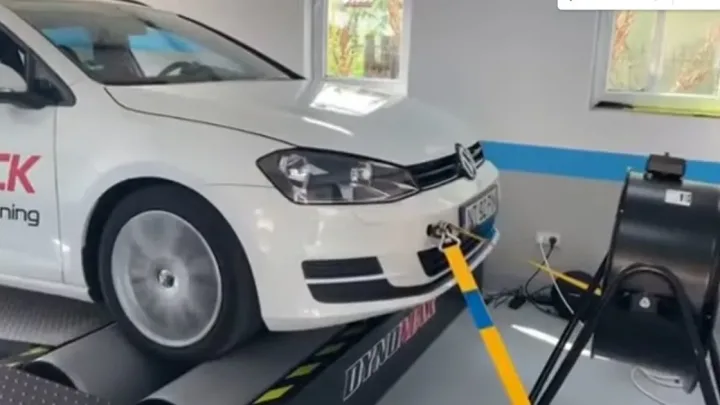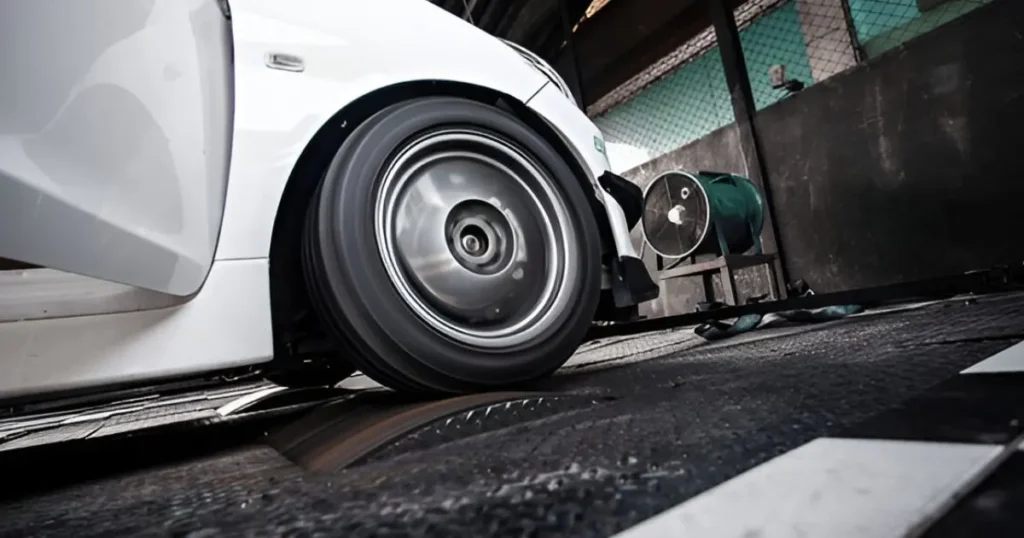
A car dynamometer measures a vehicle's power output by simulating driving conditions. It tests performance by applying resistance to the wheels or engine.
Understanding a car's full capabilities requires precise measurement tools, and a dynamometer, or 'dyno,' is a go-to device for automotive enthusiasts and professionals. This sophisticated piece of equipment gauges horsepower, torque, and other vital performance metrics. Car dynos come in two main types: chassis and engine dynos.
Chassis dynos measure power at the wheels, while engine dynos assess the engine's raw power before it reaches the drivetrain. These tests can reveal insights about a vehicle's condition, tuning needs, and potential upgrades. With the data collected, owners can make informed decisions to enhance their car's performance, ensuring every tweak and modification yields the desired effect on the road or track.
Introduction To Car Dynamometer
Imagine a treadmill for cars. That's a car dynamometer. Mechanics use it to measure a car's power. It checks engines without hitting the road. This tool helps in tuning cars for better performance. Let's dive into how these machines work.
The Car Dynamometer Basics
Car dynamometers, or "dynos," mimic driving conditions. They let cars run at full throttle while stationary. Sensors gather data on torque and power output. This information helps understand a car's performance. Dynos can diagnose problems, too.
Types Of Car Dynamometer
- Chassis Dynamometers: These measure power at the wheels. Cars drive onto rollers. The rollers measure force as the wheels turn.
- Engine Dynamometers: These test the engine directly. Mechanics remove the engine and attach it to the dyno.

The Heart Of The Machine: Core Components
Understanding how a car dynamometer works is fascinating. At the heart of this machine are core components. These parts make the dynamometer function effectively. Let's dive into these components.
Rollers And Sensors
The rollers and sensors are vital. They work together seamlessly. The car's wheels sit on the rollers. These rollers measure the car's power output. Sensors attached capture important data. This data includes speed and force. Together, they assess the car's performance accurately.
- Rollers bear the car's weight.
- Sensors record speed and force.
Car Dynamometer Braking Systems
The braking system is another crucial component. It controls the car's speed on the rollers. This ensures safety and accuracy during tests. The system can apply and release brakes effectively. This helps in measuring the car's maximum power and endurance.
- Controls car speed.
- Ensures safety during tests.
- Measures power and endurance accurately.
These components work together to test a car's performance. They make the dynamometer a powerful tool for car enthusiasts and professionals alike.
Setting The Stage: Preparation And Safety
Before diving into how a car dynamometer works, we must prepare. Safety is key in this process. Proper vehicle setup and safety measures ensure accurate results and prevent accidents.
Car Dynamometer Vehicle Setup
Getting a car ready for a dynamometer test involves several steps:
- Check fluids: Oil and coolant levels must be optimal.
- Inspect tires: They should be in good condition and inflated properly.
- Secure loose parts: Anything that could shake or fall off must be fixed in place.
- Warm up: The car needs to reach its operating temperature.
Each step is crucial for a smooth test.
Safety Measures
When running a car on a dynamometer, safety comes first:
- Wear protection: Ear and eye safety gear is necessary.
- Check surroundings: The area must be clear of people and objects.
- Emergency stop: Know how to use the dynamometer's stop function.
- Fire extinguisher: Have one nearby, just in case.
Follow these steps to protect everyone involved.

The Test Begins: Measuring Power And Performance
When cars undergo performance testing, a dynamometer is key. This device measures a vehicle's power output. Let's see how it works during a test.
Understanding Torque And Horsepower
Torque represents an engine's rotational force. It's the push that gets your car moving. Horsepower, on the other hand, is how fast the car can sustain that push over time. Think of torque as the initial punch, and horsepower as the ongoing effort.
- Torque measured in pound-feet (lb-ft).
- Horsepower is a function of torque and RPMs.
During a dyno test, the car runs at full throttle. The wheels turn large rollers on the machine. Sensors on these rollers measure torque. With this data, the dyno calculates horsepower.

Interpreting The Data
The dynamometer produces graphs that show power outputs. These graphs help mechanics and enthusiasts understand a car's performance.
| RPM Range | Torque (lb-ft) | Horsepower (hp) |
|---|---|---|
| 2000-3000 | 250 | 95 |
| 3000-4000 | 300 | 150 |
| 4000-5000 | 350 | 210 |
By analyzing these results, experts can identify performance peaks and dips. This helps in fine-tuning the vehicle for optimal power and efficiency.
Beyond Power: Other Diagnostic Capabilities on Car Dynamometer
While many know a car dynamometer measures power, its diagnostic capabilities extend far beyond. This tool offers insights into a vehicle's overall health and performance. Let's explore some other functions a dyno can perform.
Fuel Efficiency
Optimal fuel efficiency means savings and performance. A car dynamometer helps achieve this by simulating various driving conditions. It measures how much fuel your car uses under different loads. Technicians can then adjust settings to improve mileage.
- Idle Fuel Rate: Measures fuel use at a standstill.
- Load Fuel Rate: Assesses consumption under simulated driving conditions.
- Fuel Mapping: Fine-tunes the fuel system for efficiency.
Emissions Testing
A dyno also tests a car's emissions. It checks pollutants released from the exhaust. This ensures cars meet environmental standards. Cleaner emissions mean a healthier planet.
| Emission Type | Importance |
|---|---|
| CO2 | Indicates combustion efficiency. |
| NOx | Essential for air quality. |
| Particulates | Affects human health. |

From The Lab To The Road: Real-world Applications
Car dynamometers are key tools in the auto world. They measure a car's performance. Mechanics and engineers use this data for improvements. Let's explore how this lab tool helps cars on the road.
Tuning For Performance
A dynamometer, or dyno, helps tune cars for better speed and power. Car enthusiasts and race teams often use dynos. They optimize engines for peak performance. This makes cars faster and more reliable.
- Measures engine power output
- Adjusts fuel and air intake for optimal combustion
- Tests different tuning setups
Research And Development
Manufacturers rely on dynos for new car development. They test engines under various conditions. This ensures cars perform well in the real world. Safety and efficiency improve because of these tests.
- Analyze engine and vehicle performance
- Refine designs for fuel efficiency
- Improve emissions for cleaner driving
Challenges And Limitations Of Car Dynamometer Testing
Dynamometer testing is essential for understanding car performance. Yet, it has challenges and limitations. Let's explore these in detail.
Accuracy Concerns
Getting accurate results from a dynamometer test is tricky. Several factors affect accuracy. These include air temperature, humidity, and test setup. Each can change the test outcome.
For example, two cars of the same model might show different results. This is because of tiny differences in the testing environment or car condition.
Experts often run multiple tests to find an average. This helps get closer to the real performance of the car.
Car Dynamometer Vehicle Specifics
Not all cars are the same. Each model has unique features. This makes testing on a dynamometer a challenge.
- Car weight can affect the test.
- Engine type might change how the car reacts.
- Tire type can also influence results.
Customizing the test for each car is crucial. This ensures the results are as accurate as possible. Yet, it requires more time and expertise.
| Factor | Impact on Testing |
|---|---|
| Air Temperature | Can alter engine performance |
| Humidity | Affects air density, influencing engine power |
| Car Weight | Heavier cars may show different power outputs |
Understanding these challenges helps improve dynamometer testing. It allows for better preparation and more accurate results.
Looking Ahead: The Future Of Car Dynamometer
The future of dynamometry promises exciting developments. Both car enthusiasts and industry professionals eagerly anticipate these changes. Let's explore what lies ahead for this vital testing tool.
Technological Advances
New tech makes dynamometers smarter and more precise. These tools will soon offer more data than ever before. Expect to see features like:
- Real-time analytics for instant feedback.
- Advanced software integration that simplifies data interpretation.
- Improved accuracy in various conditions.
These advances aid in fine-tuning performance with ease.
Expanding Applications
Dynamometers will not just test cars in the future. Their scope is expanding. New uses include:
- Electric vehicle testing, as EVs become more common.
- Aerospace applications, where precision is key.
- Renewable energy systems, testing wind turbine motors.
These diverse applications show dynamometry's growing role.
Related Post
Top 7 Reasons Your Car Tachometer Might Be Out of Service: Critical Insights
Expert Tips: Master Car Maintenance with a Vacuum Gauge!
Car Temperature Gauge Drops: Quick Fixes & Tips
Why Your Car Water Temperature Meter Safeguards Engine Health
Oil Pressure Gauge Essentials: Must-Know Tips for Drivers
How Does a Car Dynamometer Work: Unveil the Power!
Conclusion
Understanding car dynamometers is crucial for optimizing vehicle performance. These sophisticated tools measure power output, revealing how various modifications affect your car. For enthusiasts and professionals alike, dynos provide invaluable data, guiding enhancements and ensuring peak operation. Embrace the power of the dynamometer, and take your vehicle's capabilities to the next level.
Disclosure
Some links may be affiliate links. That means we may earn a small commission at no extra cost to you.